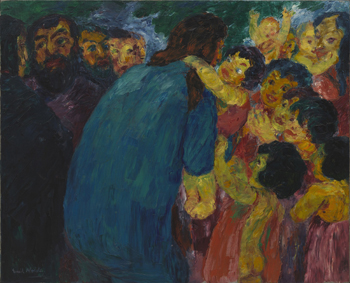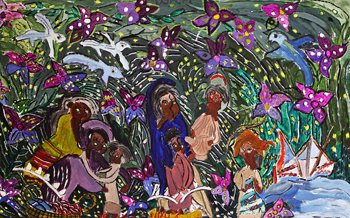For Sunday September 19, 2021
Lectionary Readings (Revised Common Lectionary, Year B)
Wisdom of Solomon 1:16-2:1, 12-22
Psalm 54
James 3:13-4:3, 7-8a
Mark 9:30-37
For the past several months, my church has held its Sunday worship services outdoors. Parishioners sit in a wide circle of folding chairs around our church labyrinth, facing the altar we’ve moved onto the church steps. Our parish children sit among us, their hands deep in the activity bins our youth minister has assembled for each child, filled with toys, stickers, books, and art supplies.
Sometimes, the youngest children get restless, and one or more of them gets up and starts walking the labyrinth in the middle of the service. While we grown-ups chant a psalm, sing a hymn, or listen to a sermon, our youngest parishioners embody the way of faith with their little feet. Sometimes, if the worship music is particularly lively, they dance. Or shout emphatic “Amens!” at the close of the Lord’s Prayer. Or wander over to the altar to get closer looks at the bread and the wine.
I suppose some folks might find this distracting, but I love it. I love the unselfconsciousness of children in worship. I love their curiosity, their intensity, their sure sense of welcome and belonging. I love that they’re honest and wholly themselves in the presence of God. When they’re delighted, we can see their joy, clear and plain. When they’re bored, hungry, sad, scared, or irritable, they let us know that, too.
In this week’s Gospel reading, Jesus takes a little child into his arms, turns to his disciples, and says, “Whoever welcomes one such child in my name welcomes me, and whoever welcomes me welcomes not me but the one who sent me.”
 |
On the face of it, this tender gesture is so small and so simple, we easily miss its radicalism. But consider this: Jesus doesn’t say, “Welcome the child because it’s a kind or loving or generous thing to do.” He says: Do you want to see what God looks like? Do you want to find God’s stand-in, hidden here among you? Are you curious about the truest nature of divine greatness? Then welcome the child. Welcome the child, and you welcome God.”
The context for this remarkable claim is an argument that breaks out among the disciples when Jesus explains — for the second time — that he will suffer, die, and rise again after three days. The disciples don’t understand a word Jesus says, but they’re too afraid to ask questions. Instead, they argue about who among them is the greatest. When Jesus asks what their quarrel is about, they refuse to answer; they're too embarrassed. But he already knows why they’re bickering, so he brings a child into their midst, gathers the child into his arms, and upends his disciples’ notions of greatness and power: “Whoever wants to be first must be last of all and servant of all.”
Perhaps if I didn’t have so much experience with children — both as a parent and as a previous children’s minister — I’d be tempted to sentimentalize Jesus’s gesture. I’ve heard well-meaning people suggest, for example, that Jesus likens children to God because children are so innocent. So good. Perhaps. But the children I know are also feisty, clever, quick, fierce, generous, selfish, naughty, obedient, curious, bored, quiet, loud, challenging, funny, surprising, creative, destructive, solemn, and exhausting. I think Jesus knew as much when he described children as trustworthy representations of God.
So what can we really learn about God by welcoming children? How can children open us up to deeper, more authentic communion with the divine? What might children teach us about greatness? Here are some possibilities:
Children show us that our imaginations are pathways to God. I spent several years teaching Sunday School, and there was rarely an occasion when I wasn’t amazed by the imaginative scope of the kids in my classroom. They could stack twenty Lego bricks together and see an entire civilization. They could cover a piece of construction paper in what looked like scribbles, and tell a fully formed story based on those wiggly lines. When I told them Bible stories, they could fill in creative details using the full range of their senses: here’s what the perfume in the woman’s alabaster jar smelled like, here’s what Peter’s callused feet in Jesus’s hands felt like, here’s what the bread at the Last Supper tasted like.
In our Gospel reading, Jesus invites the disciples to imagine a world where death doesn’t have the final word. Where inexpressible suffering gives way to irrepressible joy. Where resurrection is not merely a possibility, but a promise. But the disciples can’t make the leap. They’re bound by preconceived notions of who and what the Messiah must be, and they lack the imagination to envision a world as revolutionary as the one Jesus holds out to them. Doctrine, dogma, and theology, in other words, hold their spiritual senses captive. Welcome the child, Jesus says in response. Open your imaginations. Return to the capacity for wonder, newness, and strangeness you knew as a child.
 |
Children teach us to risk hard questions on our way to God. As I mentioned earlier, kids aren’t afraid to ask awkward, challenging, and even impossible questions. They’re naturally curious, they’re not embarrassed by their ignorance, and they’re willing to risk social discomfort to get to the truth. If they don’t understand something, they ask, and they persist in asking. In contrast, the disciples in this week’s Gospel story miss an opportunity to draw closer to Jesus, because they’re too afraid to ask hard questions. In telling them candidly about the suffering that lies in his future, Jesus offers his disciples the possibility of a deeper, more vulnerable-making intimacy with him. But they refuse the invitation, either because they don’t have the courage to admit their ignorance, or because they can’t bear to hear truths that might cause them pain. Perhaps they believe — as we so often do — that avoiding the uncomfortable stuff will save them. Whatever the case, their unwillingness to ask tough questions of themselves, of each other, and of Jesus limits their growth and their fellowship with God.
Children teach us to trust God’s abundance. Young children generally expect that there’s enough to go around. Enough time, enough hugs, enough attention, enough love. It doesn’t occur to them to fear scarcity unless they’re conditioned to do so; left to themselves, they assume plenitude.
In her memoir, The Cloister Walk, Kathleen Norris tells a beautiful story about Saint Thérèse of Lisieux. When Thérèse was four years old, she was shown a handful of colorful ribbons, and asked to choose one. Entranced, she simply responded, “I choose all.” The disciples in this week’s story, though, don’t believe that “all” is available in the kingdom of God. They don’t lean into Jesus’s generosity, sufficiency, and abundance. Believing that what’s available to them is meager and inadequate to start with, they quarrel for first place, first dibs, first prize. In response, Jesus points them to the non-striving, un-ambitious, open-hearted trust of a young child. As if to say: “Stop racing. Stop competing. Stop scrambling. There is enough. I am enough.”
 |
And finally, children teach us what divine power looks like. This, I think, is the most radical lesson of the four. A young child is the very picture of vulnerability. In some cultures, children are socially invisible. In others, they’re legally unprotected. Here in the United States, children routinely suffer the catastrophic effects of lax gun laws, cruel immigration policies, unaffordable healthcare, underfunded schools, and racist violence. In all cultures, children are at the mercy of those who are older, bigger, and stronger than they are.
And yet this — this shocking portrait of powerlessness— is the portrait Jesus offers of God. In the divine economy, power and prestige accrue as we consent to be little, to be vulnerable, to be invisible, to be low. We gain greatness not by muscling others out of our way, but by serving them, empathizing with them, and sacrificing ourselves for their well-being. Whatever human hierarchies and rankings we cling to, Jesus upends them all as he holds a tiny child in his arms. Do we want to see God? Do we really want to see God? Then look to the child abandoned in the alleyway. Look to the child detained at our border. Look to the child who has been molested. Look to the child who is fleeing from war. Look to the least of these, and see the face of God.
One of the most central and amazing truths about Christianity is that God became a helpless human infant. In this week’s Gospel story, Jesus underscores that stunning truth with another: all children represent God's heart, God's likeness, God's power. To welcome a child is to welcome the divine. To cultivate childlikeness is to cultivate godliness. To choose vulnerability is to be great in the kingdom of God.
Debie Thomas: debie.thomas1@gmail.com
Image credits: (1) Pinterest.com; (2) The Museum of Modern Art; and (3) FineArtAmerica.com.





